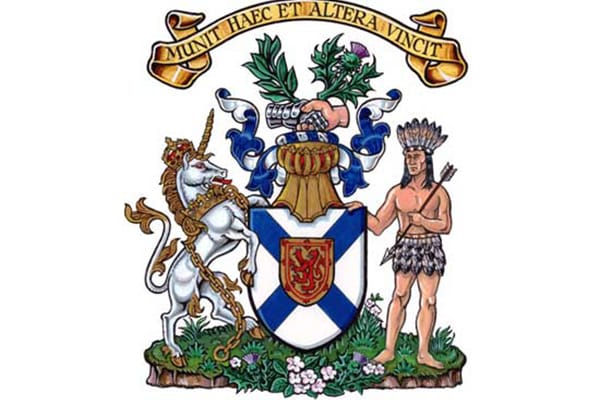Though heraldic language may call to mind medieval times, heraldry itself is alive and well.
"Gules on a Canadian pale argent a maple leaf of the first." Give this description to an elementary school class and you'll likely get blank stares. I wouldn't be surprised if their parents had the same reaction. It is the herald's way of describing the Canadian flag, using old Norman-French vocabulary. Gules is red, argent is silver or white. A pale is a central vertical division of a shield or flag. Though heraldic language may call to mind visions of medieval knights, heraldry itself is far from outdated. In fact, it remains as alive today as it was in the Middle Ages.
As in older times, every flag flown today is a heraldic statement. Every set of team colours is also heraldry. After all, the players' outfits announce which team they play for, just as the knights and their followers carried colourful shields or wore certain colours to identify themselves in battle. If you go aboard a ship of the Canadian Navy, you'll discover that every one of them is the proud bearer of a heraldic badge, a round symbol of that vessel. But you don't have to go that far to see examples of heraldry-have you ever seen a corporate logo or a trademark?

Each of the cases mentioned is an example of heraldic form adapted to modern use. They are also evidence that heraldry is not a dead relic from the past, but a very adaptable and contemporary way of indicating ownership or membership through the use of visible symbols. At the higher levels, it is both an art and a science.
When you look at coats of arms you will see a line of text, usually below the shield. The motto, a heraldic slogan, may express a belief or an ideal, state a truth, or be a war cry. So when Dalhousie University, for example, fields a team in black and gold, they are wearing sable and or, and if supporters yell, "Go, Tigers, go," they are shouting a war cry-a motto, in fact. Even in speech we use expressions with a heraldic twist. Ever heard anyone say, "I wish they'd show their true colours"?
Canada has had its own Chief Herald with the power of granting arms since 1988. If you ever considered applying for a grant of arms through the Canadian Heraldic Authority, you would need to keep three things in mind: (1) You have no right to arms, and the office may turn you down. It is rare, but possible. (2) The process takes time. It took me about two years from start to finish. (3) The cost is now about $2,000.
The process has four stages. First, you contact the authority for a personal information form. You can obtain this by going to www.gg.ca and following directions, or contacting them by phone or mail. If you supply proof of Canadian citizenship, contact information, parents' full names, your date and place of birth, a brief CV, and the names and addresses of two references, the authority determines your eligibility. A warrant is issued authorizing the process. Then, for the first time, you will be asked to pay a processing fee of about $500, taxes included.
You collaborate with them to create the shield design. There are heraldic rules about the use of colours, and the design you choose cannot be one already in use. After you and the authority have agreed on a written description, they will engage a heraldic artist to prepare a design on your behalf. You will receive an invoice from the individual artist for that service. Normally, a good craftsman will bill you between $300 and $1,000, depending on the complexity of the design.
Once all that has been dealt with, the authority proceeds to prepare and issue the letters patent, for which they send you the final bill. You will receive the patent with its hand-painted artwork showing the coat of arms, the motto and the badge you have chosen. This usually incorporates some feature in the shield or the crest.
You are then legally a bearer of arms, or armiger. Eventually the shield, crest and motto appear in the Public Register of Arms, Badges and Flags of Canada (www.gg.ca).
You then have legal ownership of a heraldic device, something to be passed on to your children and progeny, an exclusive genealogical legacy.
For more information:
Chief Herald of Canada
Canadian Heraldic Authority
Rideau Hall, 1 Sussex Drive, Ottawa, Ontario, K1A 0A1
Tel: 1-800-465-6890
Web: www.gg.ca/heraldry/index_e.asp
Dr. Terrence M. Punch is the resident genealogist on CBC radio and editor of Genealogist's Handbook for Atlantic Canada Research.
